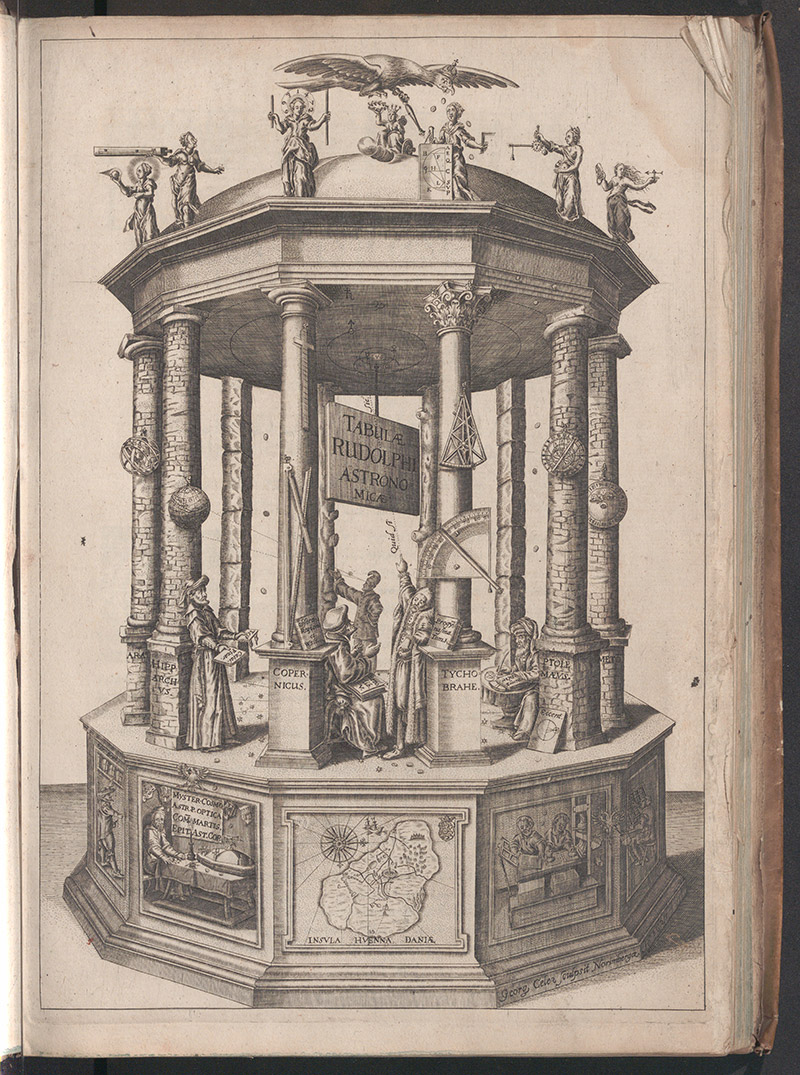Kepler and the History of Astronomy

- Engraved frontispiece.
- Tycho Brahe (1546-1601) & Johannes Kepler (1571-1630).
- Tabulae Rudolphinae, quibus astronomicae scientiae, temporum longinquitate collapsae restauratio continetur; a phenice illo astronomorum Tychone,... adque causarum et calculi perennis formula traduxit Ioannes Keplerus,...
- Ulm: Jonas Saur, 1627-[30]
The Rudolphine Tables include a poem called Idyllion, which was written by Johann Baptist Hebenstreit, the rector of the Ulm gymnasium. The poem describes the meaning of the frontispiece, which is a representation of the temple of Urania, the muse of astronomy. Essentially, the engraving summarizes the history of astronomy by depicting its most illustrious practitioners, from the Greek astronomers up to Kepler himself. Kepler’s friend Wilhelm Schickard prepared the sketch for the engraver, Johann Philipp Walch.
On top of the roof of the temple are six goddesses, each of them holding an object representing a tool or area of expertise within the discipline of astronomy. From left to right we can see optics (she is holding a lens), the telescope, logarithms (in her hands are rods of the ratio of one to two, the number around her head showing the natural logarithm of 2: 0.6931472), geometry (standing behind a diagram of an ellipse, she holds a compass and a square-ruler), the laws of the lever and balance (she is holding a balance with the Sun at the fulcrum), and magnetics (she holds a lodestone and compass). Above the roof is a depiction of royal patronage (likely an allusion to the support of the emperor Rudolph II) in the form of the imperial eagle with the scepter, showering the astronomers with a few golden coins.
At the center of the temple, just below a sign announcing the title of the book (Tabulae Rudolphi Astronomicae), is Tycho Brahe, wearing a fur robe and the medal of the elephant, the highest award from the Danish crown. Brahe is explaining to Copernicus his geocentric model of the universe, pointing out a diagram inscribed on the ceiling of the temple: the Earth is in the center with the Sun orbiting around the Earth, while the other planets revolve around the Sun. Tycho is leaning on a Cothinthian column, attached to which are two of his most important astronomical instruments, the quadrant and the sextant. A more modest column is that of Copernicus, which carries Jacob’s staff and a the parallactic ruler. The stars are depicted on the floor, symbolizing the foundation on which the observations, or columns, are built. Remarkably, the style and fabric of the columns (ten out of the twelve zodiacal columns) represent different stages in the development of astronomy. Thus, from left to right, the columns of Aratus and Hipparchus, which show an armillary sphere and a celestial globe respectively, are inelegant old structures made of bricks. Next to Aratus’ column Hipparchus is holding his Catalog of Fixed Stars in one hand and his testament in the other. The column of Ptolemy displays an astrolabe, and Ptolemy himself is drawing a geometrical figure, sitting at a table showing a book with the Greek title of the Almagest. Leaning on Ptolemy’s column is a diagram of a deferent with its center removed from the Earth. The last column represents the legacy of Meton by showing a dial with the Metonic cycle used for calculating the date of Easter: it contains the nineteen-year cycle after which the lunar phases will take place on the same date.
Lastly, the panels at the base of the temple represent, from left to right, Kepler at work, with a list of his works and a roof of the temple on the table; the island of Hven, where Brahe completed most of his astronomical work; and to the right is a depiction of a printing shop.